held in Yokohama on 15, 16 & 17 September 2000
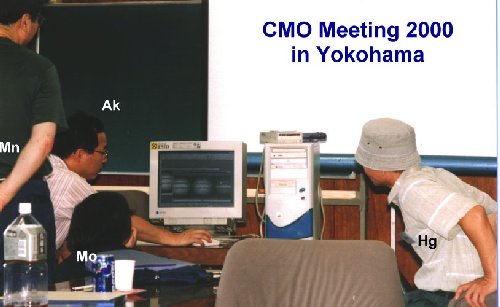


The programme of the talks to be given on the main sessions on 16 September, Saturday, was fixed as follows:
09:00 Reception
09:30 Opening Address Masami MURAKAMI
09:40 Talk 1: Planetary CCD - Practice & Problems Tomio AKUTSU
10:30 Talk 2: 2001 Apparition of Mars. I Noriaki NISHITA
11:00 Talk 3: 2001 Apparition of Mars. II Masatsugu MINAMI
12:00 Lunch
13:00 Talk 4: Recall of the 1986 Apparition of Mars Morimasa NAKAJIMA
14:00 Tea Break - HIGA's 1999 Mars Video
14:30 Talk 5: CCD Image Processing (on LRGB) Kunihiko OKANO
15:30 Talk 6: Digital Video and Digital Cameras Yasunobu HIGA
16:20 Closing Address M MINAMI
17:00 Banquet
19:00 Informal Meeting at a Hotel Lounge
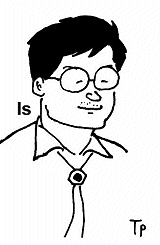
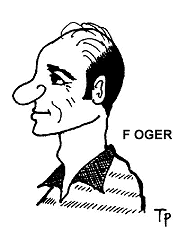 On the preceding day 15 September Friday, Y HIGA (Hg) and Tohru IWASAKI (Iw) took morning flights and were welcomed by M MURAKAMI (Mk), H TSUNEMACHI (Ts) and M MINAMI (Mn) at the Centre at about 15:00. Tomio AKUTSU (Ak) and Hiroshi NARITA (Nr) arrived in the meantime. Tsutomu ISHIBASHI (Is) also joined and we also received Francis OGER who was then staying at the Tsukuba University. We saluted and exchanged information and had pleasant conversations. Mk brought us a hot news released on 13 September 2000 of the MGS discovery of a circular (plus jet-like) dust cloud near the north polar cap (npc) on 29 August 2000 (at 042°Ls). We put heads together to the MGS image and discussed about the position of the dust, the aspect of the npc and other implications referring to several other images and data.
On the preceding day 15 September Friday, Y HIGA (Hg) and Tohru IWASAKI (Iw) took morning flights and were welcomed by M MURAKAMI (Mk), H TSUNEMACHI (Ts) and M MINAMI (Mn) at the Centre at about 15:00. Tomio AKUTSU (Ak) and Hiroshi NARITA (Nr) arrived in the meantime. Tsutomu ISHIBASHI (Is) also joined and we also received Francis OGER who was then staying at the Tsukuba University. We saluted and exchanged information and had pleasant conversations. Mk brought us a hot news released on 13 September 2000 of the MGS discovery of a circular (plus jet-like) dust cloud near the north polar cap (npc) on 29 August 2000 (at 042°Ls). We put heads together to the MGS image and discussed about the position of the dust, the aspect of the npc and other implications referring to several other images and data.
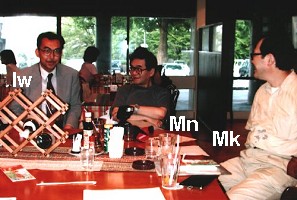
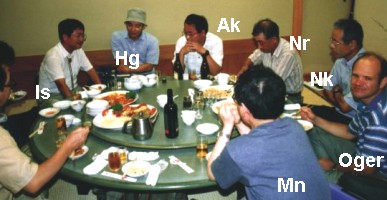
We walked then down to the famous Yokohama China Town and from 19:00 we had an Evening Party in a Chinese Restaurant, where we welcomed Morimasa NAKAJIMA (Nk) who lives in Yokohama and has been a veteran OAA Mars observer since 1956. Akinori NISHITA (Ns) also arrived there; having taken a train in a hurry after his routine work at Fukui (it takes more than 4 hours to reach Yokohama from Fukui even by the use of a bullet train). We just report that Monsieur OGER from France sang before us a Schubert Lied in German in a room of a restaurant managed by Chinese in Japan.
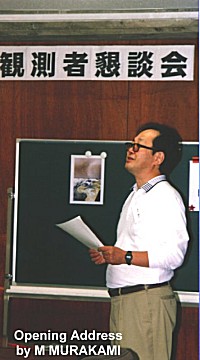 The day after, on 16 September the main session was held as scheduled. Kunihiko OKANO joined and we also welcomed H OYAMADA, a new CMO member, and H HASEGAWA, a former member. We were also happy to have several attendants from the Yokohama Astronomical Association.
The day after, on 16 September the main session was held as scheduled. Kunihiko OKANO joined and we also welcomed H OYAMADA, a new CMO member, and H HASEGAWA, a former member. We were also happy to have several attendants from the Yokohama Astronomical Association.
M MURAKAMI (Mk) opened the Meeting 2000 by welcoming the members, and reviewed briefly the outstanding Martian phenomena observed in 1999. He took the chair and invited T AKUTSU (Ak) as the first speaker.
Tomio AKUTSU(Ak) has been our member since 1986, and he has been engaged in CCD observations of the major planets since 1994 by the use of Lynxx and Teleris 2 cooled CCD cameras attached to a Newtonian having a 32cm f/6.5 speculum whose second mirror is only of 18% in size. For Mars, he uses filters R, G, B, IR extending the focal ratio to f/66 and gets 10 to 15 pieces of images within a few minutes in 2x2 binned mode. Recently he began to use the software called "StellaImage ver 3" which allows a ready and automatic composing of a lot of raw images. Unfortunately, the composites he obtained in 1999 were made in a different method, but he expects to use the soft in the coming apparition to get more sharpened images of Mars since he found it very effective to making composites of the recent images of Jupiter and Saturn. In fact, he assures us that he can get a fine composite from a hundred raw images instantaneously.
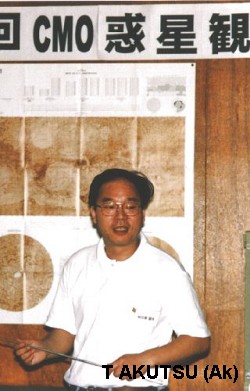 Ak briefly compared the CCD system with the old system by the emulsions. He counts it merited to use a smaller f number with a shorter exposure time, but usually available CCD chips are not always sensitive to the shorter wave lengths. In this sense, he feels that the blue light images by the TP2415 emulsion look still superior to any B images composed by the CCD chips even if the recommended KAF0400E is used. In the case of Mars, any chip must be at least better than 400E since the B image plays a specific role in the Mars observation. Sony ICX 099AL may be another candidate, but such a chip made of the back illuminated CCDs as UV2AR or Std AR made by SITe may be more useful in future. These have higher sensibility especially at the violet range.
Ak briefly compared the CCD system with the old system by the emulsions. He counts it merited to use a smaller f number with a shorter exposure time, but usually available CCD chips are not always sensitive to the shorter wave lengths. In this sense, he feels that the blue light images by the TP2415 emulsion look still superior to any B images composed by the CCD chips even if the recommended KAF0400E is used. In the case of Mars, any chip must be at least better than 400E since the B image plays a specific role in the Mars observation. Sony ICX 099AL may be another candidate, but such a chip made of the back illuminated CCDs as UV2AR or Std AR made by SITe may be more useful in future. These have higher sensibility especially at the violet range.
Ak however admitted that CCD hitherto opened variously wider ways to the planetary observations: For example, in the case of Jupiter, as he has been successful, a specific filter allows to choose lights from the methane band whose images discriminate well the upper currents from the lower ones on the Jovian surface.
Ak also touched on some troubles common to the cooled CCD cameras and gave advices how to clear them. Finally he commented that for the planetary observations the chips need not necessarily have such a million number of pixels as are used in recent digital cameras. He feels a hundred thousand of pixels are sufficient. A NISHITA (Ns) agrees with Ak's assertion as follows: Let 0.4 secs of arc be the resolution limit of a 30cm speculum and let the Jovian apparent diameter be 50 secs. Then 50/0.4 =125 implies that it is enough to slice Jupiter's disk into 125 pieces. 125x125=15,625 and even if doubled the case of 256 squared is roughly 65, 000 that is apparently smaller than a hundred thousand.
 The second talk of the morning was given by
The second talk of the morning was given by
Akinori NISHITA(Ns) on the numerical aspects of the 2001 Mars apparition. Before that, Ns pointed out that the 2003 apparition may possibly be a millennial apparition since he could find no year from 0000 to 2000 in the Table of Jean MEEUS where the planet Mars could be closer than in 2003 to the Earth. The next one to 2003 may be pinned down in 2208, and just the apparition in 2287 may bring a larger apparent diameter of Mars than in 2003.
Ns then compared the 2001 apparition with the foregoing 1954, 1969 and 1986 ones. The details shall appear in the coming CMOs, and the following is only a summary: The apparent diameter of Mars is larger than 10" arc from 136°Ls to 250°Ls in 2001. In 1986, the same season passed when the central latitude was on the southern hemisphere and in 1969 the central latitude lingered on the northern hemisphere. The case in 2001 lies between the two as in 1954, this implies also the maximal diameter was the largest in 1986 and smallest in 1969, and lies between in 2001. These years the planet approached the Earth at the sky near Sco and Sgr and so its altitude was quite lower seen from the observers in the Northern Hemisphere. Not so lower than in 1986, but the planet will goes down to -27° in declination in 2001.
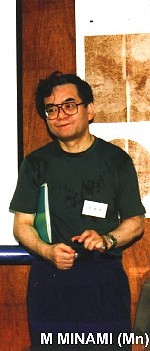 Masatsugu MINAMI (Mn) was then invited to give a talk how to observe the 2001 Mars. He first emphasised that to observe Mars is not other than to observe the seasons of Mars. He began by citing the observations of Hellas and the south polar region (spr) by S EBISAWA in 1986, the figures from l'Astronomie, juillet-août 1987 a la p410 where the varying sprs are compared at 136°Ls, at 165°Ls and at 187°Ls in 1986. These suggest as an example how to pick out the seasons and the markings. In 2001, we meet the vernal equinox of the southern hemisphere near at opposition, and so Mn talked about several checking stones to be spotted from spring to deep summer. He also emphasised to chase the seasonal phenomena diurnally by observing every 40 minutes elucidating how intrinsically the period of 40 minutes is fit to the planet Mars. Details shall be reported in future.
Masatsugu MINAMI (Mn) was then invited to give a talk how to observe the 2001 Mars. He first emphasised that to observe Mars is not other than to observe the seasons of Mars. He began by citing the observations of Hellas and the south polar region (spr) by S EBISAWA in 1986, the figures from l'Astronomie, juillet-août 1987 a la p410 where the varying sprs are compared at 136°Ls, at 165°Ls and at 187°Ls in 1986. These suggest as an example how to pick out the seasons and the markings. In 2001, we meet the vernal equinox of the southern hemisphere near at opposition, and so Mn talked about several checking stones to be spotted from spring to deep summer. He also emphasised to chase the seasonal phenomena diurnally by observing every 40 minutes elucidating how intrinsically the period of 40 minutes is fit to the planet Mars. Details shall be reported in future.
MURAKAMI thanked the speakers of the morning session and urged the audiences to introduce themselves. We had a pleasant time of conversation, and then went down to have lunch.
At 13:00 Mk vacated the chair to MINAMI (Mn), and Mn asked
Morimasa NAKAJIMA (Nk) to tell us how he observed Mars in 1986 since the 2001 apparition is similar to the 1986 one. Nk has been well known as a Mars observer since 1956 when he witnessed independently the occurrence of the great dust cloud at Noachis. He is as old as Mn, and both used to be similarly stirred up by the late Director Tsuneo SAHEKI.
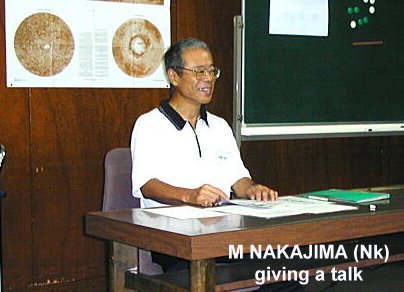 M NAKAJIMA (Nk) began his talk based on his article written in 1987 about his observations of the 1986 Mars. His method is impressive; before the arrival of each season he compiles the data of several phenomena observed in the preceding apparitions in order of Ls lest he should not miss the timing to observe them again. He really showed us the document used in 1986. It shows the Ls timings when the dark fringe appeared in 1971, the time when it became obscure, the season when the darkening wave started northwards in 1973, the Ls where the great dust storms occurred in 1956, 1971, and 1973 and so on. The northern white cloud in Hellas in 1971 and 1973, and the hazy Hellas in 1971 as well as the fainting of the south polar cap at 255°Ls in 1971 are also recorded. At that time he had two major problems to check: one was about the final state of the south polar cap (or the alternation of the polar caps), and the other about the claimed seasonal change of the colouring of the dark markings. That implied that at that time he was somewhat dubious of the opinions commonly accepted. We think he was rather right.
M NAKAJIMA (Nk) began his talk based on his article written in 1987 about his observations of the 1986 Mars. His method is impressive; before the arrival of each season he compiles the data of several phenomena observed in the preceding apparitions in order of Ls lest he should not miss the timing to observe them again. He really showed us the document used in 1986. It shows the Ls timings when the dark fringe appeared in 1971, the time when it became obscure, the season when the darkening wave started northwards in 1973, the Ls where the great dust storms occurred in 1956, 1971, and 1973 and so on. The northern white cloud in Hellas in 1971 and 1973, and the hazy Hellas in 1971 as well as the fainting of the south polar cap at 255°Ls in 1971 are also recorded. At that time he had two major problems to check: one was about the final state of the south polar cap (or the alternation of the polar caps), and the other about the claimed seasonal change of the colouring of the dark markings. That implied that at that time he was somewhat dubious of the opinions commonly accepted. We think he was rather right.
We had then a short break for coffee and tea. The break provided an occasion to show HIGA's Video images of the 1999 Mars with the Tingara music on the TV monitor as to which Mk gave a commentary (Tingara implies the Milky Way in Okinawa).
At 14:30, K OKANO (Ok) was invited to deliver a talk on some topics of the CCD image processing. This was a second time to listen to him since we had a chance to hear him at an OAA meeting at Fukui in 1994.
Kunihiko OKANO (Ok) is one of originators of the so-called LRGB composition, and he here described how he got the idea (maybe in 1997), how one can make an LRGB image, and what kind of problems remain to be solved.
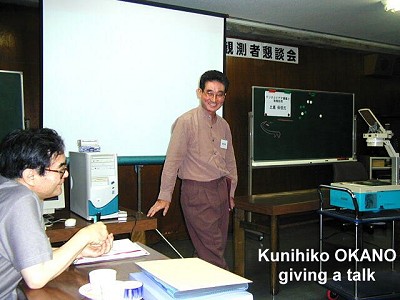 Any colour can be decomposed into three primary RGB ingredients or into CYM colours. There is however another decomposition, that is, into a Lab colour. Here one may remind of the quadricolour printing where an added black mask makes the original tricolour image quite vivid. Dr OKANO said that human eyes could not so sharply discern the boundaries of colours, and hence a poor RGB image is enough to get a more sharpened image embodied with high S/N and high resolution if another sharper high- resolved monochrome image could be got and composed appropriately. Let us suppose we obtained one high-resolved monochrome image (high-L image) at the same time with a usual poor RGB colour image. Then first convert the RGB into the Lab colour. Out of the ingredients of L, a and b, the L part should then be replaced by the high-L image. One knows then the composed image of the high-L and the original a and b components turns out to be a high resolved colour image. Ok showed the planetary ab images were quite dim, and the main information should be confined in the L image. This conversely implies that one should concentrate only on getting an excellent monochrome image: This is much (tree times) easier than getting three good R, G and B images at the same time. Since in the case of the CCD imaging, one can further shoot images with further such modes as 3x3 binned one, one can much shorten the exposure time in obtaining deep sky or planetary colour images. Thus, though it was not easy to get nice colour emulsion images of Saturn before, but the LRGB method began recently to provide lots of excellent colour CCD images of Saturn.
Any colour can be decomposed into three primary RGB ingredients or into CYM colours. There is however another decomposition, that is, into a Lab colour. Here one may remind of the quadricolour printing where an added black mask makes the original tricolour image quite vivid. Dr OKANO said that human eyes could not so sharply discern the boundaries of colours, and hence a poor RGB image is enough to get a more sharpened image embodied with high S/N and high resolution if another sharper high- resolved monochrome image could be got and composed appropriately. Let us suppose we obtained one high-resolved monochrome image (high-L image) at the same time with a usual poor RGB colour image. Then first convert the RGB into the Lab colour. Out of the ingredients of L, a and b, the L part should then be replaced by the high-L image. One knows then the composed image of the high-L and the original a and b components turns out to be a high resolved colour image. Ok showed the planetary ab images were quite dim, and the main information should be confined in the L image. This conversely implies that one should concentrate only on getting an excellent monochrome image: This is much (tree times) easier than getting three good R, G and B images at the same time. Since in the case of the CCD imaging, one can further shoot images with further such modes as 3x3 binned one, one can much shorten the exposure time in obtaining deep sky or planetary colour images. Thus, though it was not easy to get nice colour emulsion images of Saturn before, but the LRGB method began recently to provide lots of excellent colour CCD images of Saturn.
In the case of Mars, however, it is not easy to get an appropriate high-L monochrome image: If one uses a clear R or IR image as L, then it will never reproduce the white clouds and/or mists and the images could never be realistic. So Dr OKANO feels a need to combine the information from the violet range someway into the L image, where one may use the colour conversion filters to warm up the colour-temperature or use much more-sensitive-in-blue CCD chips such as back-illuminated UV2AR (made by the SITe; much superior to Kodak 400E chip). At any rate, the LRGB method for Mars should not be said yet fully established.
Dr OKANO also alluded to a possible usefulness of the wedge prisms to cancel the light dispersions since the planet Mars in 2001 will be quite low in the southern sky. He also mentioned about the AO, though yet the AO-7 is only applicable to a limited kind of SBIG cameras and also at present it is only used for Jupiter in the planetary world because it has bright satellites, but Ok however feels it may bring a further possibility.
We don't here repeat, but Ok talked much about the ambiguity of colouring when we make the colour images. The real colour is somewhat different from the preferred colour, and he ironically suggested one could only reproduce the preferred colour of the planets even if one dares to try to make it real.
The last talk of the afternoon session was given by Y HIGA (Hg) from Okinawa.
Yasunobu HIGA (Hg) first talked about the weather and seeing conditions and other situations in Okinawa since he and Hiroshi ISHADOH are planning to invite several of the CMO Mars observers to Okinawa to observe Mars when it will be at millennial opposition in 2003.
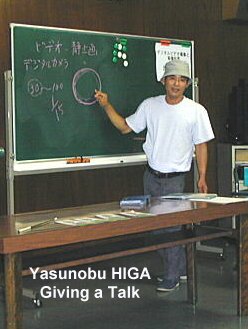 Hg's main talk was about the difference of qualities of the still images processed from the moving images by the Digital Video Sony Camera and the digital images obtained by the use of the new Nikon digital camera COOLPIX990 (2048x1536 pixels, 8 bit). He used some Jupiter images recently shot to compare. He is not yet fully convinced, but he thinks the Nikon image gives a more fruitful description near the round limb, though at the inside the Sony image looks to show the detail. Anyway any digital camera is more handy, and so he seems to try to use the Nikon digital camera for the coming Mars. We must however remember that the Sony 3CCD chips reproduced the shorter wave light with a peak at 500nm to the effect that Hg's Video images have been excellent to produce the white cloud phenomena hitherto, and so the spectrum curve of the Nikon chip should first be known whether it is appropriate to shoot the planet Mars.
Hg's main talk was about the difference of qualities of the still images processed from the moving images by the Digital Video Sony Camera and the digital images obtained by the use of the new Nikon digital camera COOLPIX990 (2048x1536 pixels, 8 bit). He used some Jupiter images recently shot to compare. He is not yet fully convinced, but he thinks the Nikon image gives a more fruitful description near the round limb, though at the inside the Sony image looks to show the detail. Anyway any digital camera is more handy, and so he seems to try to use the Nikon digital camera for the coming Mars. We must however remember that the Sony 3CCD chips reproduced the shorter wave light with a peak at 500nm to the effect that Hg's Video images have been excellent to produce the white cloud phenomena hitherto, and so the spectrum curve of the Nikon chip should first be known whether it is appropriate to shoot the planet Mars.
Time ran out, and Mn thanked all the speakers and participants. Before closing, Mk received a telephone call from Yukio MORITA (Mo) at Hiroshima, who just finished his work (he is a dentist) and would be to take a train from the Hiroshima station to meet us. It takes about five hours by the use of a Shinkansen (bullet train) from Hiroshima to Yokohama.
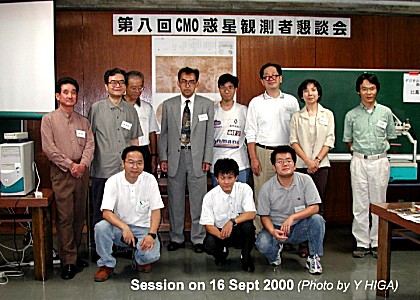
From 17:00 we had a banquet. At the occasion,
M NAKAJIMA told us an interesting story:
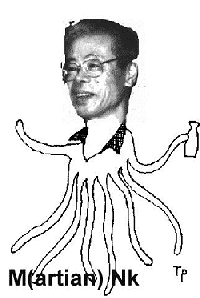 As is well known, a radio-broadcasting of a drama scenario made by Orson WELLES of the H G WELLS's The War of the Worlds got up a panic in America on 30 October 1938 (31 Oct JST), while M NAKAJIMA was born the following day on 1 November 1938, and hence he believes he has been a Martian (who must have been incarnated in Japan avoiding the panicky US).
As is well known, a radio-broadcasting of a drama scenario made by Orson WELLES of the H G WELLS's The War of the Worlds got up a panic in America on 30 October 1938 (31 Oct JST), while M NAKAJIMA was born the following day on 1 November 1938, and hence he believes he has been a Martian (who must have been incarnated in Japan avoiding the panicky US).
Near at 19:00 MORITA (Mo) arrived, and we had another meeting in a hotel lounge (as scheduled) to welcome Mo who had then conversations with us, especially with the CCD members AKUTSU and HIGA for a few hours.
The final day on 17 September, we also had an informal meeting at the Centre in the morning: Nk and Mn summarised their talks (for the sake of Mo). Tohru IWASAKI (Iw) talked then about how the colour of the Syrtis Mj underneath a morning mist should be called as well as how the northern mouth of Hesperia looked like in 1984 and 1999. T AKUTSU used his favourite PC to show us how he image processed the recent Jovian images by the use of the StellaImage ver 3. His HD had a lot of planetary images including Don PARKER's Martian ones.
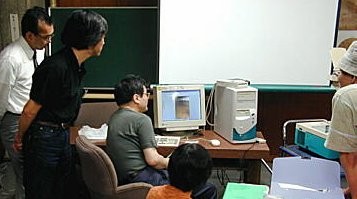
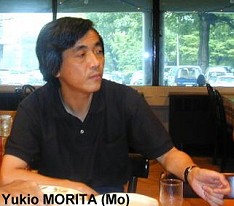
The session was closed at noon. Several still continued to chat after moving to a quiet coffee house, but we finally late in the afternoon adjourned the CMO Meeting until a next occasion. It was happy, as we heard later, that Hg landed safely at the remotest Naha Airport near at 23:00 on the day.
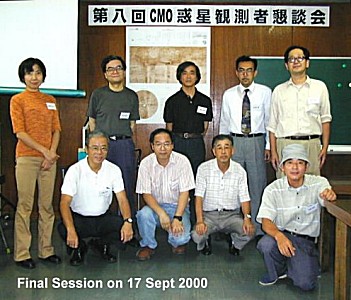
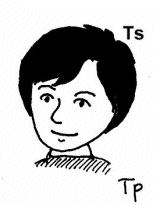
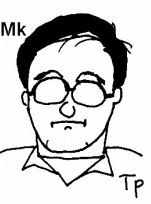 To close, we would like to thank again all the participants. Special thanks are due to Masami MURAKAMI (Mk) and Hitomi TSUNEMACHI (Ts) for their kind arrangements of such a nice encounter of the CMO members at Yokohama in the memorial 2000.
To close, we would like to thank again all the participants. Special thanks are due to Masami MURAKAMI (Mk) and Hitomi TSUNEMACHI (Ts) for their kind arrangements of such a nice encounter of the CMO members at Yokohama in the memorial 2000.
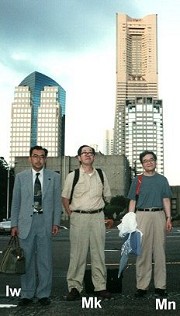 Tohru IWASAKI (Iw) at the leftmost visited Yokohama and Tokyo on the occasion of the Meeting. He joined the Meeting members on 15 Sept at Yokohama.
Tohru IWASAKI (Iw) at the leftmost visited Yokohama and Tokyo on the occasion of the Meeting. He joined the Meeting members on 15 Sept at Yokohama.
Left: there are seen some buildings of the Yokohama MM21
behind Iw, MURAKAMI and MINAMI (left to right; photo by ISHIBASHI).
Yokohama, with its port opened in 1859, has now a population of 3.3 millions, and is the second largest city in Japan. The Tokyo downtown is only separated from the centre of Yokohama by 30 km. Iw attended the CMO seminars at Yokohama on 15, 16 and 17 Sept, and then went to Tokyo to listen to a VERDI Opera of the genuine Teatro alla Scala from Milano on 19 Sept.
Some information about the Yokohama MM 21 is given on
http://web.infoweb.ne.jp/mm21/english/index.html